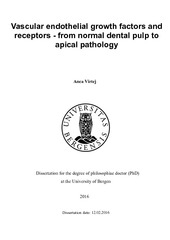| dc.contributor.author | Virtej, Anca | en_US |
| dc.date.accessioned | 2016-06-13T11:12:27Z | |
| dc.date.available | 2016-06-13T11:12:27Z | |
| dc.date.issued | 2016-02-12 | |
| dc.identifier.isbn | 978-82-308-3389-6 | en_US |
| dc.identifier.uri | https://hdl.handle.net/1956/12098 | |
| dc.description.abstract | The VEGFs -A, -B, -C, -D are important signaling molecules with pivotal implication in the growth of blood and lymphatic vessels, the so-called angio- and lymphangiogenesis. They exert their activities by binding to their receptors, VEGFRs-1, -2 and -3. Their involvement in pathologic processes such as tumor growth or inflammatory disorders has been thoroughly described, rheumatoid arthritis being just one example. The VEGF family represents the link between angiogenesis and bone turnover, as seen in cancer metastasis to the bone or arthritis. Furthermore, they are involved in the differentiation of dendritic cells and lymphocytes, while macrophages and PMNs have been identified as sources of VEGFs, showing a mediatory function of these molecules in immune responses. The presence of VEGF-A and its main angiogenic receptor VEGFR-2 in well- vascularized normal dental pulp has been previously described. Apical periodontitis, a common inflammatory disease caused by the interaction of root canal bacteria with the host immune response, is characterized by bone resorption. VEGF-A is also known to be present in these lesions of endodontic origin. However, the picture of VEGF family and their receptors with respect to location and function in the dental pulp and in periapical pathology have so far been incomplete. The aims of this thesis were to identify and map the presence of VEGF family and their receptors VEGFR-2 and -3 in apical periodontitis and dental pulp and to investigate their role in periapical disease development. In normal rat apical periodontium (Paper I), VEGF-A, -C, -D and VEGFR-2 and -3 were present on blood vessels. Upon endodontic exposure for periapical disease development, an intensification of immunohistochemically stained vascular structures was noticed. Macrophages and neutrophils expressed all VEGFs and VEGFRs in the lesions, with macrophages being an important source of VEGF-C and -D. Osteoclasts were the source for VEGFR-2 and -3. The gene expression of VEGF-A and VEGFR- 3 was significantly up-regulated following pulp exposure. The results suggest the implication of VEGF family and their receptors in the periapical immune response, vascular remodeling and in bone resorptive activities. In human periapical lesions (Paper II) VEGFs and VEGFRs were expressed on blood vessels and on macrophages, PMNs, B- and T-lymphocytes. At the gene level, significant up-regulations were recorded for genes involved in VEGF-mediated angiogenic activity, such as phosphatidylinositol-3-kinases (Pl3K), protein kinase C (PKC), mitogen-activated protein kinases (MAPK) and phospholipases (PL). These findings suggest the implication of VEGF family in ongoing immune reactions along with vascular remodeling in human established periapical lesions. The normal dental pulp (Paper III) presented with blood vessels, macrophages and T- lymphocytes positive for the same VEGFs and VEGFRs. Furthermore, VEGF-B was only seen at cellular level in the dental pulp. Twenty-six of 84 VEGF signaling genes, including VEGFR-3 were significantly altered in the dental pulp compared with control PDL. The pulpal tissue has high VEGF signaling capacity with respect to immune responses and vascular activity. Using specific markers for lymphatic vessels, we confirmed the absence of lymphatic vessels from both apical periodontium and the dental pulp. Macrophages expressing LYVE-1 were found in human periapical lesions and the dental pulp, with an assumed angiogenic role. Upon inducing periapical lesions we systemically blocked VEGFR-2 and/or -3 in order to investigate their signaling patterns with respect to lesion size, angiogenesis, local inflammatory response and lymphangiogenesis in the draining lymph nodes (Paper IV). We have found that VEGFR-2 reduces inflammation whereas combined VEGFR-2 and -3 signaling causes an increase of the process, seen in amounts of PMNs and osteoclasts, as well as different cytokines expression. In the regional lymph nodes, lymphangiogenesis is dependent on VEGFR-2 and/or VEGFR-3 signaling. The results of these studies provide evidence on the presence of VEGFs and VEGFRs in dental pulp and apical periodontitis, with implications in immune responses and vascular remodeling. VEGFR-2 and/or -3 signaling influences inflammatory reactions during periapical disease development. | en_US |
| dc.language.iso | eng | eng |
| dc.publisher | The University of Bergen | eng |
| dc.relation.haspart | Paper I: Bletsa A, Virtej A, Berggreen E (2012): “Vascular endothelial growth factors are up-regulated during development of apical periodontitis”, Journal of Endodontics; 38(5):628-35. This article is not available in BORA. The published version is available at: <a href="http://dx.doi.org/10.1016/j.joen.2012.01.005"target="blank">10.1016/j.joen.2012.01.005</a> | en_US |
| dc.relation.haspart | Paper II: Virtej A, Løes SS, Berggreen E, Bletsa A (2013): “Localization and signaling patterns of vascular endothelial growth factors and receptors in human periapical lesions”, Journal of Endodontics; 39(5):605-11. This article is not available in BORA. The published version is available at: <a href="http://dx.doi.org/10.1016/j.joen.2012.12.017"target="blank">10.1016/j.joen.2012.12.017</a> | en_US |
| dc.relation.haspart | Paper III: Virtej A, Løes S, Iden O, Bletsa A, Berggreen E (2013): “Vascular endothelial growth factors in normal human dental pulp: a study of gene and protein expression”, European Journal of Oral Sciences; 121(2):92- 100. This article is not available in BORA. The published version is available at: <a href="http://dx.doi.org/10.1111/eos.12019"target="blank">10.1111/eos.12019</a> | en_US |
| dc.relation.haspart | Paper IV: Virtej A, Bletsa A, Papadakou P, Pytowski B, Sasaki H, Berggreen E (2015): “VEGFR-2 reduces while combined VEGFR-2 and -3 signaling increases inflammation in apical periodontitis”. Manuscript. This article is not available in BORA. | en_US |
| dc.title | Vascular endothelial growth factors and receptors - from normal dental pulp to apical pathology | en_US |
| dc.type | Doctoral thesis | |
| dc.rights.holder | Copyright the author. All rights reserved. | |
